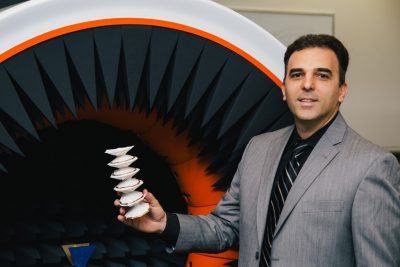Origami antennas enable new aerospace and tactical systems for communication and sensing

The Air Force Office of Scientific Research has awarded FIU a $4.8 million grant to launch the Center for Physically Reconfigurable and Deployable Multifunctional Antennas. The center will be led and directed by researcher Stavros Georgakopoulos, associate professor in the Department of Electrical and Computer Engineering at FIU’s College of Engineering and Computing and inventor of foldable origami antenna systems.
The goal of the center is to develop innovative and advanced origami-based antenna technologies for next-generation Air Force and Department of Defense systems.
“These technologies will provide groundbreaking capabilities to Air Force and military communication, reconnaissance, sensing and energy harvesting systems that are used by aircraft, drones and satellites,” said Georgakopoulos. “Specifically, the center will use geometric origami, computational design methods and novel materials to enable the development of antennas that can change their shape to dynamically adapt to varying operating conditions, as well as antennas that can be compactly stowed, easily collapsed and quickly deployed. These antennas will provide unprecedented electromagnetic and mechanical performance to aerospace systems and will also increase the agility of soldiers and ground personnel in the battlefield.”
Georgakopoulos pioneered the development of the first-generation origami electromagnetic systems through a previously awarded National Science Foundation (NSF) Emerging Frontier in Research and Innovation (ERFI) grant, which was co-funded by the Air Force Office of Scientific Research. Inspired by the Japanese art of paper folding, origami electromagnetic systems include reconfigurable, foldable and deployable multifunctional antennas and antenna arrays, adaptable “smart skins” for communication and sensing, and compact/collapsible wearable antennas.
When antenna systems are launched into space, they must fit into very small compartments. While in orbit, they must effortlessly deploy into very large sizes to communicate with ground stations on earth. Also, soldiers have traditionally relied on heavy, bulky and static antennas to share intelligence from the field. Origami antennas will revolutionize airborne and spaceborne systems and increase soldiers’ mobility on the ground by providing ultra-compact stowage, easy deployment, reduced weight and multifunctional utility.
“Such antennas will be crucial for the military as they are smart, dynamic, lightweight, and easy-to-launch,” continued Georgakopoulos. “Soldiers can easily carry them in their backpacks.”
The center plans to establish partnerships and collaborations with the government and private companies in the industry to become a research and development hub that will focus on discovering cutting-edge antenna technologies.
The center’s research team includes assistant professors Elias Alwan and Shubhendu Bhardwaj and professor Sakhrat Khizroev from FIU’s Department of Electrical and Computer Engineering (ECE); Pezhman Mardanpour, assistant professor from FIU’s Department of Mechanical and Materials Engineering; John Volakis, professor of ECE and dean for the College of Engineering and Computing at FIU; and Manos Tentzeris, professor for the School of Electrical and Computer Engineering at Georgia Institute of Technology.
“This award demonstrates our investments and leadership in radio frequency (RF) technologies, as well as materials and microwave communications systems, in an effort to provide more opportunities and research projects for our engineering students,” said Volakis. “The center is set to generate a team of well-trained graduate and undergraduate students in wireless technologies and serves the growing needs of the Department of Defense and commercial companies. The center provides a good venue for our students to work more closely with the industry and network with professionals in the field.”
For more information, visit the RFCOM Lab website.






